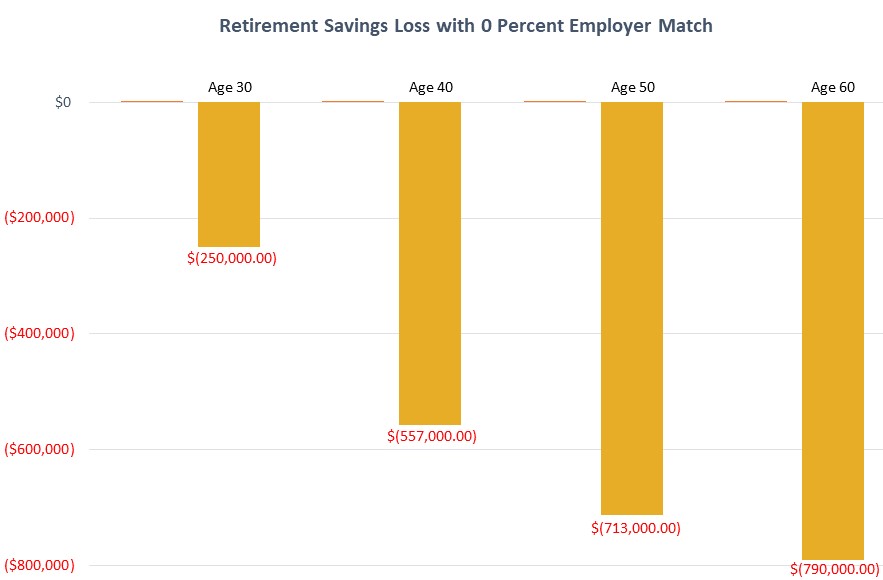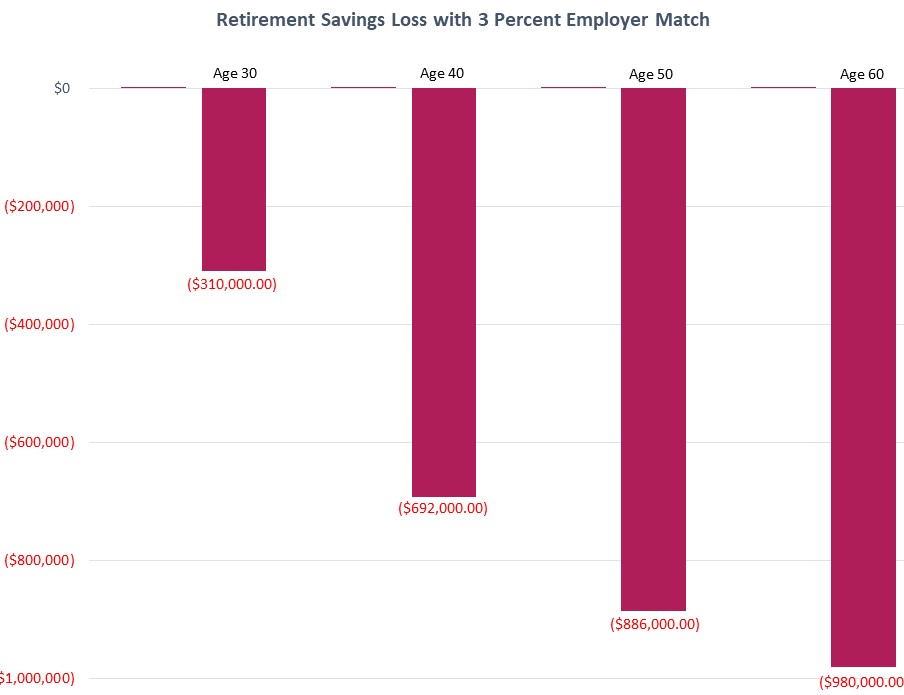Three biggest
money mistakes
that women make
Three of the biggest money mistakes women make are: 1) delay saving for retirement 2) not investing enough for retirement 3) invest too conservatively.
One thing we realize more than ever these days is that money is power. And that if you don’t have as much as the guys do, it can put you in a tough position. It can keep you in a job you don’t want to do. It can keep you in a relationship you don’t want to be in. It can keep you from taking that trip around the world or starting that business you’ve been dreaming about.
(Sallie Krawcheck)
Mistake #1: Delay saving for retirement
The average American worker starts saving for retirement at 31-years-old.[1] By delaying retirement saving and investing, you miss out on almost a decade of compounding, employer matching and tax savings and, thus, forego hundreds of thousands of dollars in your retirement accounts. Don’t believe me? GOBankingrates conducted a study to determine how much the average workers lose in retirement savings when they delay contributing.[2] Here are the study’s assumptions:
· Median household income: $57,652
· Average 401k annual contribution: 6.2%
· Average annual return: 6.5% (net of
inflation = 2%)
· Retirement age: 65 years old
Here are two “flavors” of the study’s output:
Exhibit 1

Exhibit 2

The loss from delaying savings is ASTOUNDING. In a retirement plan with 0 percent employer match, a recent college graduate who waits until age 30 to contribute will lose out on $250,000 in savings. For plans with a modest 3 percent employer match, the delay results in a $310,000 loss in savings. Unfortunately, the picture worsens with each decade you defer. Compared to the average single man, the average single woman’s net worth is 3 times less.[3] The sooner you save, the sooner you put that money to work for you.
Recommendations:
· Start saving/investing right now whether you’re in your 20s or 50s. Can’t find the money? Lower your living expenses, especially housing and car ownership, as they’re typically the biggest costs.
· Automate your contributions to eliminate dithering and delay.
Mistake #2: Don’t invest enough for retirement
According to Fidelity, one of the largest record keepers of retirement accounts, the average employee contribution is $6,970 annually while the average employer match is $4,040 for a combined total of $10,980.[4] Unfortunately, women overall invest about 40 percent less money than men.[5] This is a by-product of wage inequality where women make about 80 – 83 cents on the dollar for doing the same work as men.[6] Unfortunately, women live about 3-5 years longer than men, which translates to about $194,000 in additional out-of-pocket healthcare costs. Further exacerbating this problem is the fact that women take more time out of the workforce to care for children and aging parents. On average, women spend 44 percent of adult life out of the workforce compared to 28 percent for men.[7] As a result, women on average earn about $1 million less than men who stayed continually in the workforce. Less earnings means less savings.
Recommendation:
· Max out your 401k every year by finding ways to cut expenses.
· Consider maxing out a Roth IRA if you qualify and are still in your 20s and early 30s. By putting away after-tax money while you’re (likely) still in a lower tax bracket, you will benefit greatly from compounding your savings in a tax-free account with no stipulations on when you’ll have to withdraw the money.
· Automate your contributions so you can acclimate to living on less.
Mistake #3: Invest too conservatively
Studies seem to suggest that women are more conservative investors than men.[8]
· Women have less confidence in their investing abilities than men.
· Women are more concerned about wealth preservation versus wealth accumulation.
· Women typically earn less than men and, thus, are more inclined to hold onto what they have.
· Women have greater context (e.g., family and friends) for investing and so are more inclined to invest more conservatively.
Regardless of what the reasons may be, you need to understand the impact of your (more) conservative investing style. When you own stocks, you own businesses. And, businesses are powerful growth engines. Additionally, by trying to lower your risk by lowering your stock allocation, you take on another risk – outliving your savings. See below for the average gross return of different assets.
|
Assets |
Average gross return (annual) |
|
Balanced mutual funds (80/20)[9] |
9.5% |
|
Real estate [10] |
3.7% |
|
Cash |
2% |
When it comes to asset allocation, publications have often cited this rule-of-thumb:
100 – Your age = Stock allocation
Given the financial, professional, psychological and social headwinds that women face, I’m more inclined to propose this revised equation:
120 Percent – Your Age = Stock allocation
|
Age |
Math |
Percent in Stocks |
|
20s |
120 – 20 (age) |
100 percent |
|
30s |
120-30 (age) |
90 percent |
|
40s |
120 – 40 (age) |
80 percent |
|
50s |
120 – 50 (age) |
70 percent |
|
60s |
120-60 (age) |
60 percent |
|
70s |
N/A |
60 percent |
NOTE: It’s always best to check with a financial professional to make sure that your allocation reflects your personal situation: age, income, assets, time horizon, risk tolerance, etc.
NOTE: Please consult a financial professional t
Recommendation:
If your 401k offers a target date fund (TDF), consider this set-it-and-forget-it investment option. As you draw closer to your retirement date, the fund will reallocate more assets to bonds and less to stocks.
Final thoughts
Women face a lot of social, professional and financial headwinds. However, by saving early, saving a lot and taking more risks, we can overcome many of these obstacles. In so doing, collectively, we will kill the prevailing bag lady syndrome once and for all.
[1]“Smart money moves in your 20s and 30s,” Nationwide Retirement Institute, 2018.
[2]“Waiting too long to save for retirement will cost you,” GoBankingRates, April 2019.
[3]“The Wealth Gap,” Investor Business Daily, July 2018.
[4]“Does your company’s 401k plan stack up with everyone else’s?” MarketWatch, June 2019.
[5]“Why women invest 40 percent less than men (and how we can change it),” NBC News, September 2018.
[6]“Why women invest 40 percent less than men (and how we can change it),” NBC News, September 2018.
[7]“Wage Gap: For women taking time off to care for family can cost them $1 million in a lifetime,” The Mercury News, April 2018.
[8]“Women and financial wellness,” Merrill Lynch, 2018.
[9]“Vanguard Portfolio Asset Allocation Models,” Vanguard, 2019.
[10]“Is buying a home overrated?” NPR, April 2019.
RECENT POSTS
March 2025
Although 2024 double-digit stock market return suggests a strong US economy, the recent change in government leadership and policies highlights the underlying risk (uncertainty) that now weighs down the market and tests American exceptionalism.
December 2024
The fifth anniversary of my advisory firm and the holiday season have prompted me to reflect on my Life’s journey so far and, in so doing, unexpectedly arrive at an unconventional perspective on gifting.
October 2024
August steep market decline serves as a useful dress rehearsal for how we might react in a bear market and what we should do now to increase survival.
Get a free financial education.
Learn more about key financial topics, such as investing, 401k, disability insurance, paying for a home, at your own convenience. Sign up for Women’s Wealth monthly newsletter and have relevant information delivered to your inbox.

Live life on your own terms.
Do you find yourself constantly stressed or bored at work and wondering when you can live life on your own terms? Learn how to harness money’s energy and begin to create your life rather than manage it.
CONNECT
Anh Thu Tran
Women’s Wealth LLC
P.O. Box 1522
Tacoma, WA 98401
anhthu@womenswealthllc.com
(206) 499-1330
Women’s Wealth LLC is a Washington State registered investment advisor. The presence of this website on the Internet shall not be directly or indirectly interpreted as a solicitation of investment advisory services to persons of another jurisdiction unless otherwise permitted by statute. Follow-up or individualized responses to consumers in a particular state by our firm in the rendering of personalized investment advice for compensation shall not be made without our first complying with jurisdiction requirements or pursuant an applicable state exemption. For information concerning the status or disciplinary history of a broker-dealer, investment advisor, or their representatives, a consumer should contact their state securities administrator.
© 2021 Women’s Wealth LLC. All rights reserved. | Design by Erin Morton Creative, LLC.



